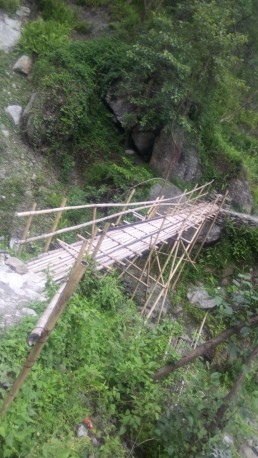Chhaya Vani Namchu
“Can the subaltern speak?”
Many years ago, I read this essay by Gayatri Spivak as part of my undergraduate syllabus. I cannot recollect too much detail about it now, but 7-8 years down the line, what has stuck with me through the years is its title.
Today, I work as a researcher on climate change and its impacts on mountain communities, and specifically women in these communities. Sometimes I feel the pressure to provide academic and statistical information which I feel, although fair to research, reduces the people I interview to data and objects. But work is work and I understand that even my research will eventually help communities in the long term (I hope).
When carrying out fieldwork in my study site, I come across stories which may be considered too simple for the academic discourse, but which can be thought provoking nonetheless. One of my field sites in Kalimpong, a beautiful community village, is affected by erratic rainfall that leads to massive landslides and floods that eventually end up blocking communities during monsoons, effects that can in part be attributed to climate change.
Predominantly a Lepcha village, the route to this village is through chor batos. The village has no infrastructure and has several streams that need to be crossed through bridges constructed using locally available bamboo by the local residents. There are about 3-5 such bridges. I visited the village in the dry season when there was no water, rain or flooding.
The indigenous communities of the mountains are very resilient and independent, as opposed to the larger perception (and rightly so) around them facing hardships such as commuting, accessing drinking water, walking hours through rough terrain to get to the nearest school, etc. It’s true that these communities are marginalized, economically as well as educationally, and face multiple hardships, but this is only one side to them. They undertake many initiatives by themselves that involve working together as a community, and aren’t the (usually expected) rescue projects.
Coming back to my field trip to this village. I had set out with an agenda as part of my job to interview and draw information on the changes in the climate experienced by the indigenous Lepcha women through questions such as:
- What variations in temperature and rainfall have you noticed?
- How has it changed your cropping pattern?
- What are the challenges faced during monsoons?
- Have you noticed other climatic changes?
And so on..
On one such day after I got done with the more formal interview, and as I was retiring my notebook to my bag and getting ready to leave, I got into an informal chat with these women. We discussed the weather, the village, and the walk back to town. Small talk. I shared my fear of shaky wobbly bridges with them while dreading the journey that lay ahead of me. And just then, a woman well into her forties, who was also very vocal in my group discussion, spoke in agreement with me. Her solidarity with my fear was heartening mostly because of the story she narrated next, and the jolly-as-ever casual tone that she took.
She said that the bridge indeed made life very uncomfortable for them. Sometime back, she set out on her way to the weekly Saturday market to Kalimpong town, wearing a pair of high heels as she usually does. As she was crossing the bamboo bridges, her heel got stuck between two bamboo logs. She added, in between bouts of laughter, that she was extremely embarrassed. There she was, all dressed up, sitting on the bridge, trying to get her heels out of the space in between the bamboo logs. Even though she didn’t want to be seen by anyone in that rather hilarious situation, she found it extremely funny herself. Just a minor glitch in the mundane order of the day.
This incident was very interesting to me. Most of us would wear trekking shoes and trekking clothes to visit such areas. But what is trekking and hiking to us is their daily route and daily life. The above narrative shows that this life is as normal to them as is dressing up to catch drinks at Hauz Khas village for so many of us city people. And although places like these require help in policies and infrastructure, I hope that in the discourse on Mountains, the resilient women are not treated as rescue projects alone.
This brings me back to Spivak’s- Can the subaltern speak?- that communities and especially women are not subaltern objects, and that if we really had to talk to them and listen to them without a set of questions- what would they say?


